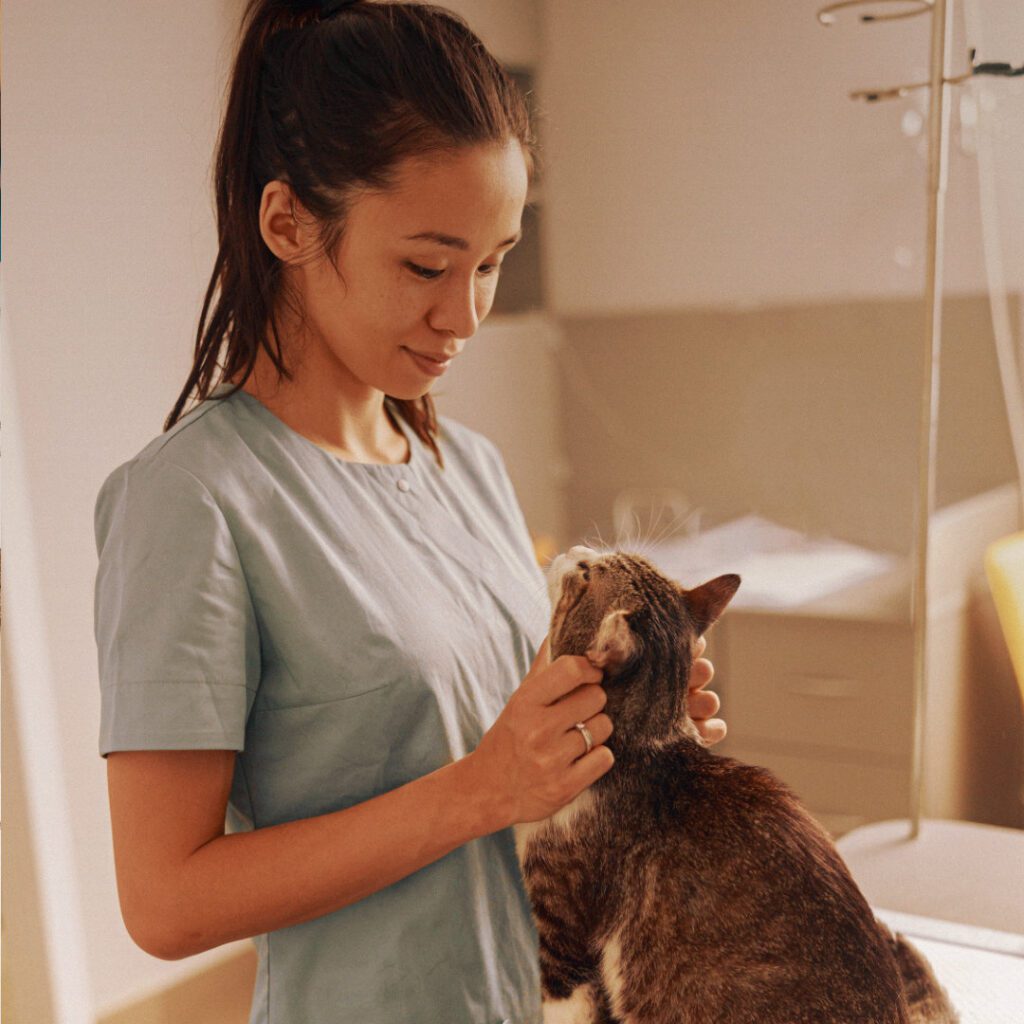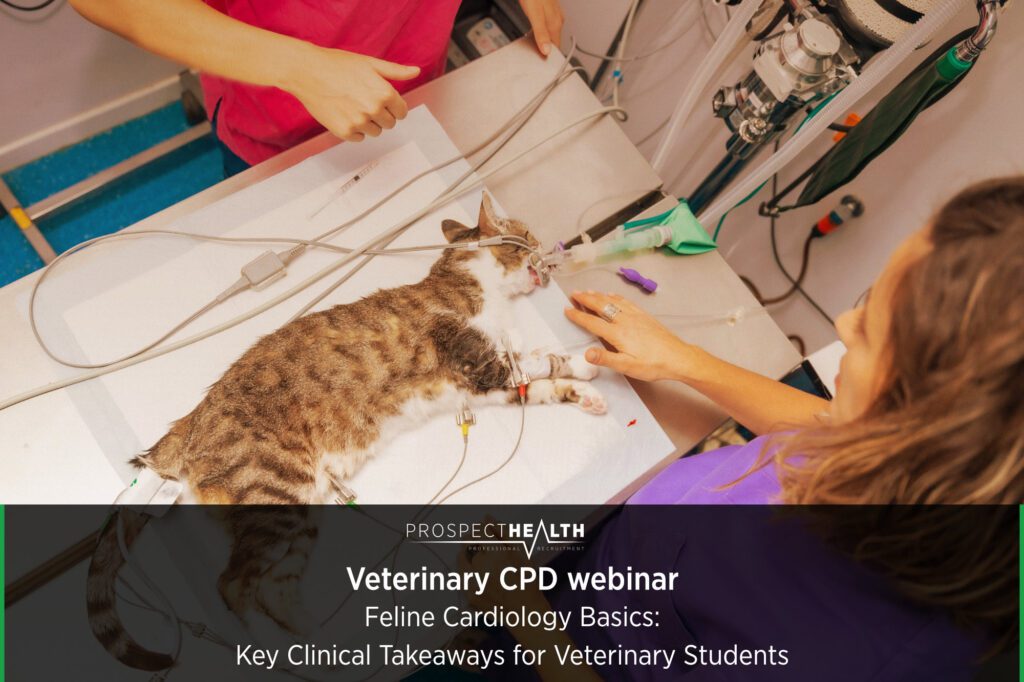November 4, 2025 | Vet Student | Veterinary
Veterinary CPD webinar
Feline Cardiology Basics: Key Clinical Takeaways for Veterinary Students
Based on a webinar by Dr. Catherine Georges, DVM, DACVIM (Cardiology)
Cardiology in cats can be challenging, they’re subtle patients, often showing vague or inconsistent signs of disease.
In this webinar, Dr. Catherine Georges, a newly boarded cardiologist, shared essential concepts and clinical insights on feline cardiology to help students understand how to approach cardiac disease in cats.
If you would like to receive a copy of the webinar recording and be added to our mailing list for future webinars, please complete the form below.

Access our pre-recorded Veterinary Webinars
1. Screening for Heart Disease in Cats
Unlike dogs, cats can have significant heart disease without a murmur.
- Gallop rhythms are more concerning than soft murmurs.
- Murmurs may be dynamic — they can appear or disappear depending on stress level, anemia, or excitement.
- Clinical signs are often nonspecific: lethargy, weight loss, tachypnea, hindlimb weakness, or collapse.
Pro tip for owners: Purring can make cats appear tachypneic. Teach owners to count resting respiratory rates when the cat is calm and not purring.
Screening Options
- Plan A (Gold standard): Echocardiogram, blood pressure, T4, ± thoracic radiographs.
- Plan B: Chest radiographs, NT-proBNP, blood pressure, T4.
- Plan C: NT-proBNP, T4, blood pressure, and home monitoring of resting respiratory rate.
⚠️ Interpret NT-proBNP carefully: it’s cleared by the kidneys, so cats with kidney disease may have falsely elevated results.
Also note: cats often have dynamic right ventricular outflow tract obstructions — benign causes of soft, variable murmurs that don’t always indicate structural heart disease.
2. Common Acquired Cardiac Diseases
Hypertrophic Cardiomyopathy (HCM)
- The most common heart disease in cats.
- Genetic predispositions: Maine Coons and Sphynx (tests available but not fully predictive).
- Secondary causes: Hypertension, hyperthyroidism, hypovolemia (“pseudo-hypertrophy”), acromegaly.
- Echocardiographic findings: Concentric hypertrophy ± left atrial enlargement.
- Dynamic obstruction (HOCM): Caused by systolic anterior motion (SAM) of the mitral valve → murmur.
Treatment notes:
- For asymptomatic cats, clopidogrel is more effective than aspirin in reducing thromboembolic risk.
- Limited evidence supports ACE inhibitors, pimobendan, or spironolactone use in cats.
Transient Myocardial Thickening
- Seen in young cats after stress or systemic illness (e.g., viral infection, trauma).
- Echo findings can mimic HCM initially but normalize with recovery.
- Serial echocardiography helps differentiate this from true HCM.
Restrictive Cardiomyopathy (RCM)
- Characterized by biatrial enlargement with normal or thin walls and poor relaxation.
- Can resemble advanced HCM or DCM.
- Prognosis depends on degree of diastolic dysfunction.
Dilated Cardiomyopathy (DCM)
- Rare today but historically linked to taurine deficiency.
- May occur secondary to systemic illness (e.g., sepsis).
- Check for retinal degeneration in suspected taurine-deficient cats.
3. Congenital Heart Diseases
Ventricular Septal Defect (VSD)
- The most common congenital cardiac defect in cats.
- Produces a loud systolic murmur, often right parasternal.
- Prognosis is variable: some cats remain stable, while others develop CHF or pulmonary hypertension.
- Goal: minimize shunting and manage symptoms; sometimes beta-blockers like propranolol are used.
Patent Ductus Arteriosus (PDA)
- Presents with a loud continuous murmur (though continuous component may be hard to detect).
- No sex predilection in cats.
- If flow is not reversed, surgical ligation offers an excellent prognosis.
⚡ 4. Arrhythmias in Cats
- Arrhythmias are uncommon unless secondary to another condition (e.g., HCM, hyperthyroidism).
- Hyperthyroid cats may have frequent VPCs or tachyarrhythmias — treat the underlying endocrine disease first.
- Avoid lidocaine: cats are highly sensitive, with risk of CNS and cardiovascular depression.
Common patterns to recognize:
- Atrial fibrillation: Irregularly irregular rhythm, no P waves.
- Sinus arrhythmia or purring artifact: Regular rhythm or vibration pattern that mimics fibrillation.
- Hyperkalemia: Bradycardia, absent P waves, tall T waves — often seen in blocked cats.
💔 5. Common Complications of Feline Heart Disease
- Congestive Heart Failure (CHF): May cause pleural effusion, pulmonary edema, or pericardial effusion. Cats often “choose” one manifestation per episode.
- Atrial Thromboembolism (ATE): Painful, often presents as acute hindlimb paralysis (the “five P’s”: pain, pallor, pulselessness, paralysis, poikilothermy).
- Sudden death: Possible in severe cardiomyopathy.
- Pericardial effusion: More commonly due to CHF than neoplasia in cats.
Emergency management of CHF:
- Furosemide (1 mg/kg IV/IM), oxygen, minimal stress handling.
- Clopidogrel for clot prevention once stable.
- Pimobendan or ACE inhibitors may be added later depending on echo findings.
ATE management:
- Aggressive pain control (methadone, fentanyl CRI — not buprenorphine).
- Supportive care ± concurrent CHF management.
- Monitor for reperfusion injury and hyperkalemia during recovery.
- Physiotherapy is often required; prognosis is guarded but can improve over weeks.
Final Thoughts
Cats are unpredictable when it comes to cardiac disease — clinical signs are subtle, murmurs are unreliable, and progression varies widely.
Dr. Katrin emphasized a few key reminders for students:
- Don’t rely solely on auscultation.
- Always assess respiratory effort and rate.
- Serial monitoring and echocardiography are invaluable.
- Be cautious interpreting BNP in renal cats.
- Above all, tailor your diagnostic and therapeutic approach to each individual cat and its owner’s resources.
If you’re looking to move roles after graduation or if you’re looking for a role once you graduate our team can help
You can call us on 01423 813453 or email us at [email protected]
View all our Veterinary Jobs

Next Up: Veterinary CPD webinar
Understanding Anaemia in Dogs and Cats: A Comprehensive Guide
Anaemia is a common finding in veterinary practice, and understanding it is crucial for accurate diagnosis and treatment. While it can sometimes be the primary reason a pet is brought to the clinic, it often serves as a signal of an underlying health issue.
In this webinar, Dr Stephanie Mitze demystifies anaemia and helps you understand the common causes, presentations and diagnosis.

Talk to a specialist
Chris Ellerker
Divisional Director – Dentistry and Locum Vet Divisions
I have over 12 years of recruitment experience, working my way up from Candidate Resourcer, Recruitment Consultant, Business Manager, to Divisional Director. I manage/run our Dentistry and Locum Vet teams here at Prospect Health. I thoroughly enjoy finding candidates a rewarding position that meets their expectations and supporting them through the process of registration/compliance (the fun bit), as well as throughout their placement/booking…
November 4, 2025 | Vet Student | Veterinary



